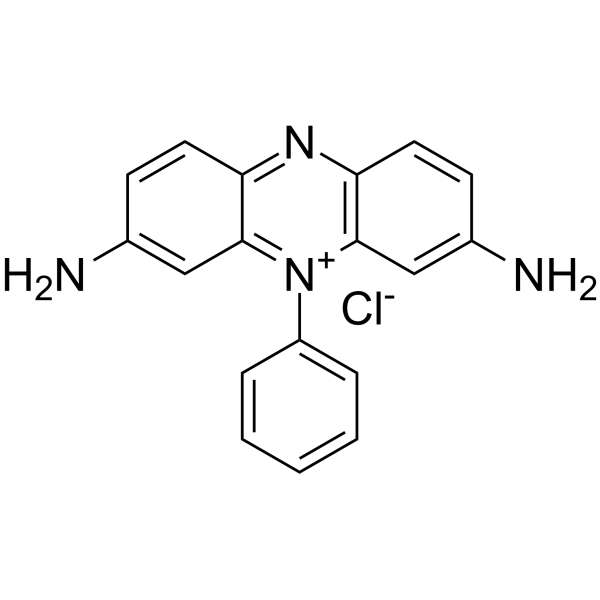

奎诺二甲基酯结构式

|
常用名 | 奎诺二甲基酯 | 英文名 | Phenosafranine |
|---|---|---|---|---|
| CAS号 | 81-93-6 | 分子量 | 322.792 | |
| 密度 | 1.1738 (rough estimate) | 沸点 | 478.49°C (rough estimate) | |
| 分子式 | C18H15ClN4 | 熔点 | 300ºC | |
| MSDS | 中文版 美版 | 闪点 | N/A | |
| 符号 |

GHS07 |
信号词 | Warning |
|
Spectrophotometric and spectrofluorometric studies on interaction of cationic dyes with bacterial capsular polysaccharide.
Indian J. Biochem. Biophys. 35(4) , 241-6, (1998) Interaction of Klebsiella K14 capsular polysaccharide with cationic dyes pinacyanol chloride, acridine orange and phenosafranin has been studied by spectrophotometric and spectrofluorometric techniques. The polymer containing both glucuronic acid and pyruvic ... |
|
|
Sulfite Oxidase Catalyzes Single-Electron Transfer at Molybdenum Domain to Reduce Nitrite to Nitric Oxide.
Antioxid. Redox Signal. 23 , 283-94, (2015) Recent studies suggest that the molybdenum enzymes xanthine oxidase, aldehyde oxidase, and mARC exhibit nitrite reductase activity at low oxygen pressures. However, inhibition studies of xanthine oxidase in humans have failed to block nitrite-dependent change... |
|
|
A promising dehydrogenase-based bioanode for a glucose biosensor and glucose/O2 biofuel cell.
Analyst 137(9) , 2233-8, (2012) A new type of dehydrogenase-based amperometric glucose biosensor was constructed using glucose dehydrogenase (GDH) which was immobilized on the edge-plane pyrolytic graphite (EPPG) electrode modified with poly(phenosafranin)-functionalized single-walled carbo... |
|
|
Differentiation of Salmonella typhi using resistotyping.
J. Appl. Bacteriol. 54(2) , 171-6, (1983)
|
|
|
An amperometric nitrate reductase-phenosafranin electrode: kinetic aspects and analytical applications.
Bioelectrochemistry 64(1) , 61-70, (2004) The enzyme-catalysed reduction of nitrate was studied utilising Aspergillus niger nitrate reductase (NR) and phenosafranin in solution as the enzyme regenerator, working at lower potentials than that of the more common methyl viologen mediator. Cyclic voltamm... |
|
|
Spectroscopic characterization of the interaction of phenosafranin and safranin O with double stranded, heat denatured and single stranded calf thymus DNA.
J. Fluoresc. 21(1) , 247-55, (2011) Interaction of phenosafranin and safranin O with double stranded, heat denatured and single stranded calf thymus DNA has been studied by fluorescence, absorbance and circular dichroic techniques. Binding to the double stranded and heat denatured DNA conformat... |
|
|
Studies on the molecular interaction of phenazine dyes with Triton X-100.
Spectrochim. Acta. A. Mol. Biomol. Spectrosc. 60(8-9) , 2093-7, (2004) The absorption spectra of phenazine dyes such as phenosafranin (PSF), safranin-O (Saf-O), and safranin-T (Saf-T) in aqueous solution of Triton X-100 (TX-100) show that phenazine dyes form 1:1 charge-transfer (CT) or electron-donor-acceptor (EDA) complex with ... |
|
|
Energy transduction by nitrogenase: binding of MgADP to the MoFe protein is dependent on the oxidation state of the iron-sulphur 'P' clusters.
Biochem. J. 291 ( Pt 3) , 709-11, (1993) Hydrolysis of MgATP to MgADP is essential for nitrogenase action. There is good evidence for binding of both nucleotides to the Fe protein of nitrogenase, but data indicating their binding to the MoFe protein have been controversial [see Miller and Eady (1989... |
|
|
Spectroscopic studies on the spontaneous assembly of phenosafranin on glycosaminoglycans templates.
Spectrochim. Acta. A. Mol. Biomol. Spectrosc. 58(12) , 2613-9, (2002) Spectroscopic studies showed that binding of phenosafranin (PSF) molecules to glycosaminoglycans (GAGs) resulted in the following observations: (i) appearance of a 52.6 nm hypsochromic shift of the visible absorption band; (ii) static quenching of fluorescenc... |
|
|
Studies of Triton X-165-beta-cyclodextrin interactions using both extrinsic and intrinsic fluorescence.
J. Colloid. Interface Sci. 347(2) , 252-9, (2010) The interaction of beta-cyclodextrin with the non-ionic micelle-forming surfactant Triton X-165 (TX-165) has been studied using steady state fluorescence and fluorescence anisotropy techniques. Both extrinsic and intrinsic fluorescence have been exploited for... |